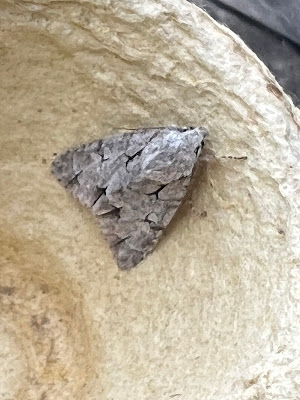
I was walking along the canal towpath yesterday in intermittent sunshine when I saw a vivid, unusual chip of russet brown jinking along, too small to be a Comma and brighter than a Gatekeeper. I managed to follow it for a while but then it disappeared and I carried on with my humble grocery expedition.

When I checked the moth trap the following morning, I found a major suspect: the Vapourer Moth shown above, with its 'eyes' whose placing reminds me of Naught Nora in that most excellent, rhyming children's book. It is an unuausal creature with a fine caterpillar as my younger sister discovered earlier this year when she lighted on one in her garden in Bradford. I remember finding one beside me some years ago when I was high up in our treehouse, trying to make a bit of aerial walkway less unsafe. I took the picture below but kept away from those long hairs which can cause a rash.

Only the male Vapourer has wings capable of flight; the female resembles a woodlouse and spends her life on a tree trunk waiting to mate and lay eggs. The scented pheromones which they use to attract suitors give the species its name. Like Emperor moths, which are highly susceptible to their females' pheremones, the male Vapourer also flies by day frequently, interestingly when he is blessed with such handsome antennae which usually come into their own for moths when it is dark.

One of the commonest moths in the trap at the moment is the Flame Shoulder, whose rather exciting name was mocked dismissively by my granddaughter who thought it a great exaggeration. I will show her my second photo, below, which makes the object of her scorn a little more dramatic.


Second generation moths are around now, freshly-hatched and lovely, including this Grey Dagger which I most associate with the earlier emergence in the Spring. Welcome also a Setaceous Hebrew Character and a delicate Latticed Heath, one of the best of the moths which pretend to be butterflies when at rest.
I need to spend a little time with
the Moth Bible to ID this rather finely-patterned arrival below whose complicated designs remind me of William Morris wallpaper.
Update: I put the suggestion of Cabbage Moths to the wondrous Upper Thames Moths blog and bingo! I was right. Under him or her, we have a Marbled Beauty examining my wedding ring, then another but less interesting ID puzzle for me
(Update: actually it turned out to be very interesting - see next post) followed by the first of this year's Copper or Svennson's Copper Underwings with their wholly distinctive little monocle.
It was nice to have a Common Marbled Carpet on the bulbholder, a spindly Scarce Footman and a Nut-tree Tussock with its wings unusually widely-spread.
Next we have a lightish Dark Arches, a third ID query which I recognise and should nail soon but can't immediately, a Lime-speck Pug (the Bird Poo moth) and two views of an attractive August Thorn.
Less happily, I have been keeping a rigorous eye on the nasturtiums chosen by Large - and Small - Whites as a breeding ground. I am afraid that I place our interests in the form of cabbages, broccoli and Brussels sprouts above those of the caterpillars.
I found a very plump, solitary Large White one only yesterday and I am sure that, Darwin style, some will escape my vigilance. Finally, here is a lovely male Banded Demoiselle keeping its cool as I approach, plus proof that I can occasionally get the focus right for that other, very common day-flying moth, the Silver Y.



























No comments:
Post a Comment